Analysis of Functional Organizations and Enhanced Learning Strategies
VerifiedAdded on 2021/04/21
|19
|4396
|243
Report
AI Summary
This report analyzes functional organizations, focusing on enhanced learning strategies within higher education. It examines the concept of flipped classrooms and blended learning, contrasting them with traditional teaching methods. The report delves into the principles of functional learning, exploring its application and design. It emphasizes the importance of student engagement, technology integration (including Office 365, Sway, SharePoint, Padlet, BYOD, and TweetTopic), and cooperative work. The discussion suggests an enhanced method of functional learning, highlighting the need for personalized learning experiences. The report also touches on the challenges faced by higher education institutions in adapting to modern demands and provides recommendations for improvements. The report uses existing literature and provides insights for students to adapt in a rapidly changing environment.
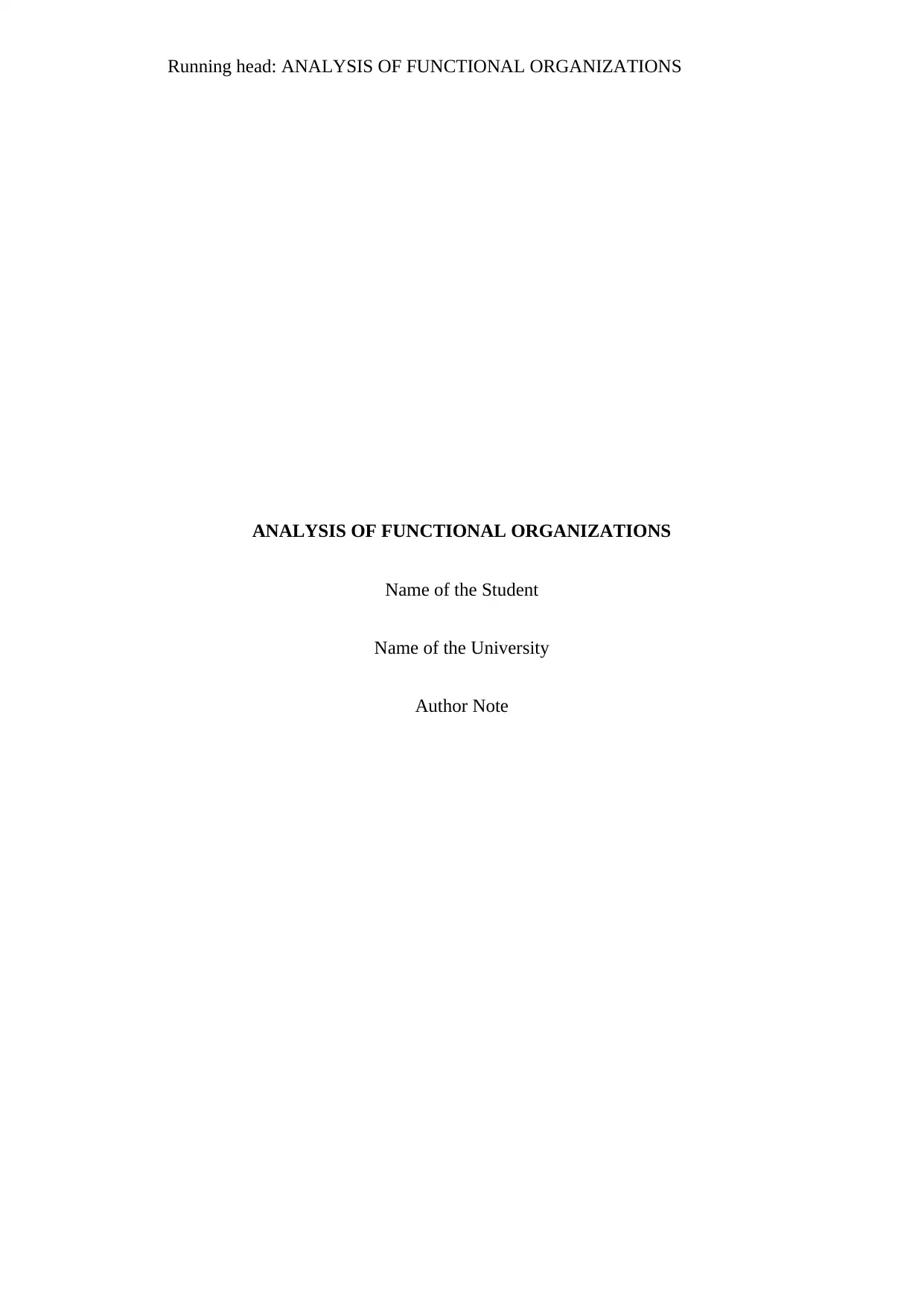
Running head: ANALYSIS OF FUNCTIONAL ORGANIZATIONS
ANALYSIS OF FUNCTIONAL ORGANIZATIONS
Name of the Student
Name of the University
Author Note
ANALYSIS OF FUNCTIONAL ORGANIZATIONS
Name of the Student
Name of the University
Author Note
Paraphrase This Document
Need a fresh take? Get an instant paraphrase of this document with our AI Paraphraser
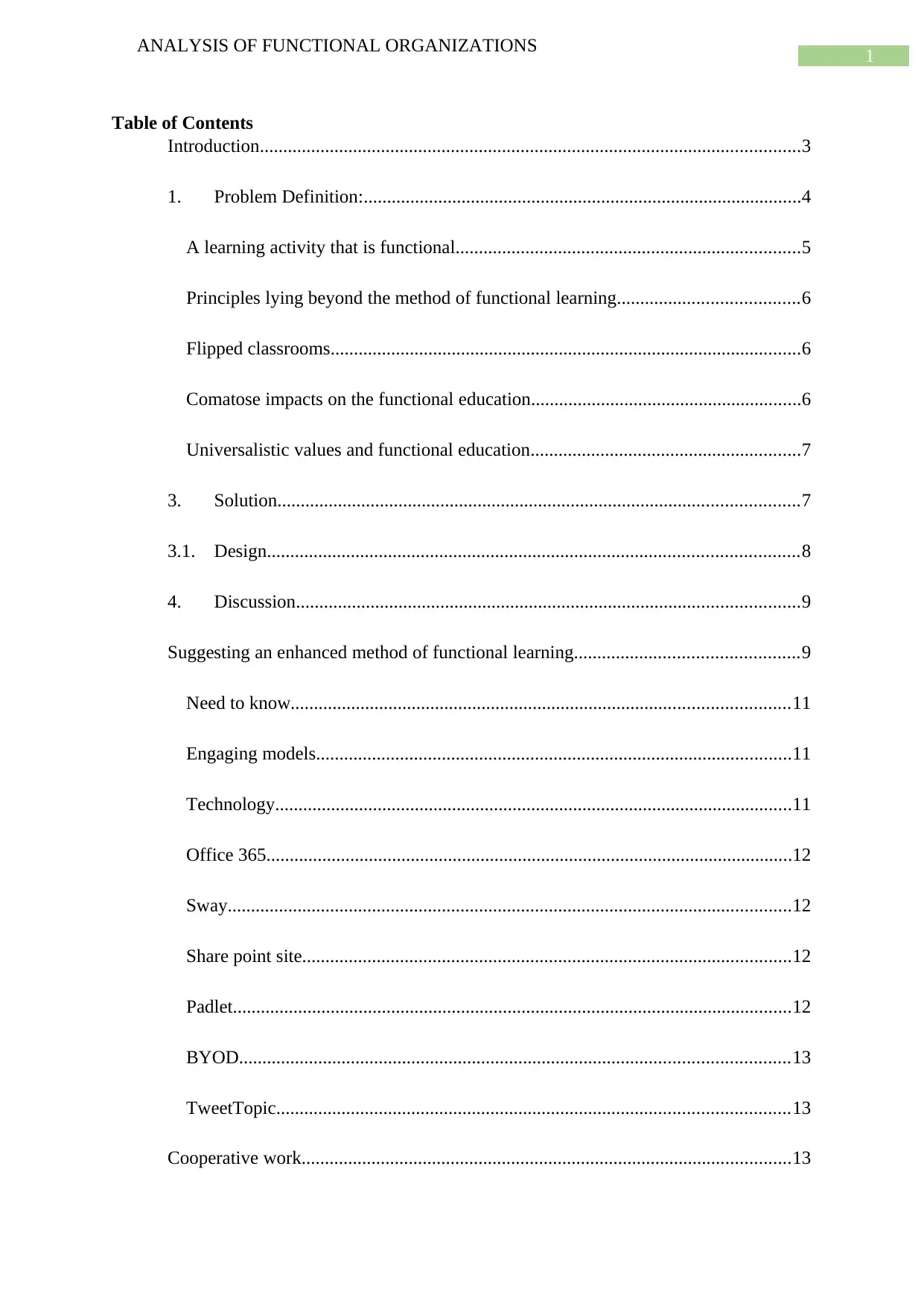
1
ANALYSIS OF FUNCTIONAL ORGANIZATIONS
Table of Contents
Introduction....................................................................................................................3
1. Problem Definition:..............................................................................................4
A learning activity that is functional..........................................................................5
Principles lying beyond the method of functional learning.......................................6
Flipped classrooms.....................................................................................................6
Comatose impacts on the functional education..........................................................6
Universalistic values and functional education..........................................................7
3. Solution................................................................................................................7
3.1. Design..................................................................................................................8
4. Discussion............................................................................................................9
Suggesting an enhanced method of functional learning................................................9
Need to know...........................................................................................................11
Engaging models......................................................................................................11
Technology...............................................................................................................11
Office 365.................................................................................................................12
Sway.........................................................................................................................12
Share point site.........................................................................................................12
Padlet........................................................................................................................12
BYOD......................................................................................................................13
TweetTopic..............................................................................................................13
Cooperative work.........................................................................................................13
ANALYSIS OF FUNCTIONAL ORGANIZATIONS
Table of Contents
Introduction....................................................................................................................3
1. Problem Definition:..............................................................................................4
A learning activity that is functional..........................................................................5
Principles lying beyond the method of functional learning.......................................6
Flipped classrooms.....................................................................................................6
Comatose impacts on the functional education..........................................................6
Universalistic values and functional education..........................................................7
3. Solution................................................................................................................7
3.1. Design..................................................................................................................8
4. Discussion............................................................................................................9
Suggesting an enhanced method of functional learning................................................9
Need to know...........................................................................................................11
Engaging models......................................................................................................11
Technology...............................................................................................................11
Office 365.................................................................................................................12
Sway.........................................................................................................................12
Share point site.........................................................................................................12
Padlet........................................................................................................................12
BYOD......................................................................................................................13
TweetTopic..............................................................................................................13
Cooperative work.........................................................................................................13
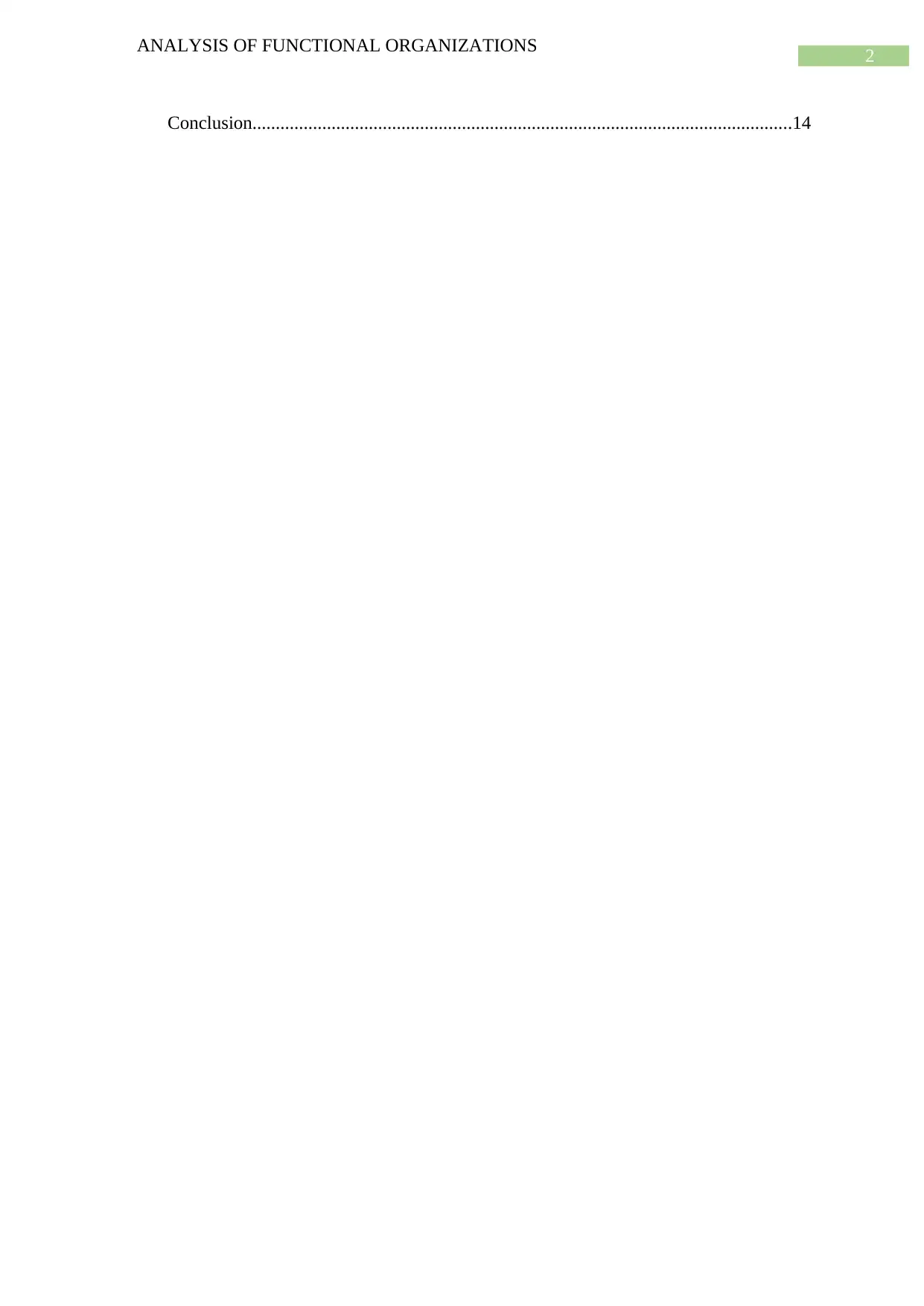
2
ANALYSIS OF FUNCTIONAL ORGANIZATIONS
Conclusion....................................................................................................................14
ANALYSIS OF FUNCTIONAL ORGANIZATIONS
Conclusion....................................................................................................................14
⊘ This is a preview!⊘
Do you want full access?
Subscribe today to unlock all pages.

Trusted by 1+ million students worldwide
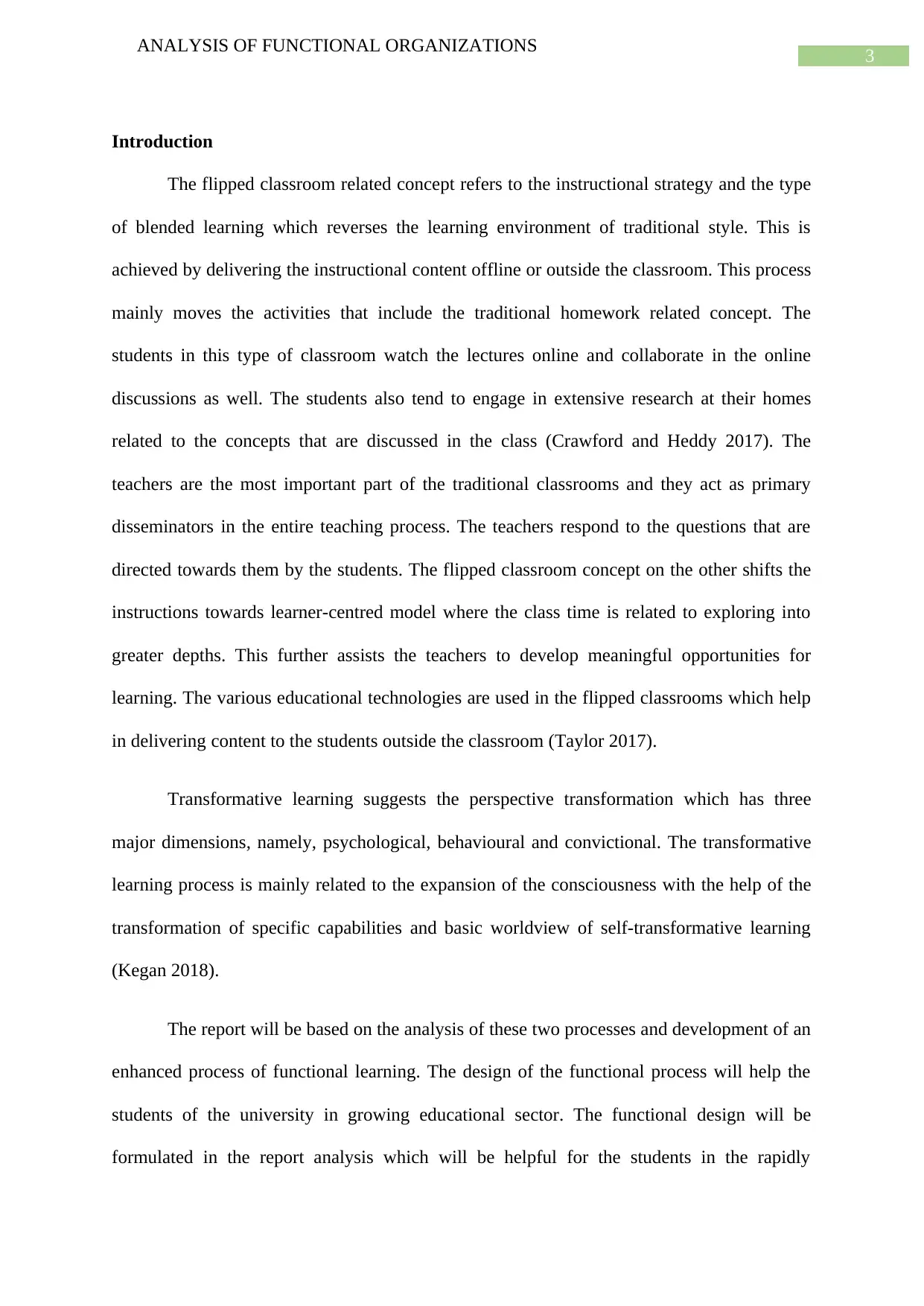
3
ANALYSIS OF FUNCTIONAL ORGANIZATIONS
Introduction
The flipped classroom related concept refers to the instructional strategy and the type
of blended learning which reverses the learning environment of traditional style. This is
achieved by delivering the instructional content offline or outside the classroom. This process
mainly moves the activities that include the traditional homework related concept. The
students in this type of classroom watch the lectures online and collaborate in the online
discussions as well. The students also tend to engage in extensive research at their homes
related to the concepts that are discussed in the class (Crawford and Heddy 2017). The
teachers are the most important part of the traditional classrooms and they act as primary
disseminators in the entire teaching process. The teachers respond to the questions that are
directed towards them by the students. The flipped classroom concept on the other shifts the
instructions towards learner-centred model where the class time is related to exploring into
greater depths. This further assists the teachers to develop meaningful opportunities for
learning. The various educational technologies are used in the flipped classrooms which help
in delivering content to the students outside the classroom (Taylor 2017).
Transformative learning suggests the perspective transformation which has three
major dimensions, namely, psychological, behavioural and convictional. The transformative
learning process is mainly related to the expansion of the consciousness with the help of the
transformation of specific capabilities and basic worldview of self-transformative learning
(Kegan 2018).
The report will be based on the analysis of these two processes and development of an
enhanced process of functional learning. The design of the functional process will help the
students of the university in growing educational sector. The functional design will be
formulated in the report analysis which will be helpful for the students in the rapidly
ANALYSIS OF FUNCTIONAL ORGANIZATIONS
Introduction
The flipped classroom related concept refers to the instructional strategy and the type
of blended learning which reverses the learning environment of traditional style. This is
achieved by delivering the instructional content offline or outside the classroom. This process
mainly moves the activities that include the traditional homework related concept. The
students in this type of classroom watch the lectures online and collaborate in the online
discussions as well. The students also tend to engage in extensive research at their homes
related to the concepts that are discussed in the class (Crawford and Heddy 2017). The
teachers are the most important part of the traditional classrooms and they act as primary
disseminators in the entire teaching process. The teachers respond to the questions that are
directed towards them by the students. The flipped classroom concept on the other shifts the
instructions towards learner-centred model where the class time is related to exploring into
greater depths. This further assists the teachers to develop meaningful opportunities for
learning. The various educational technologies are used in the flipped classrooms which help
in delivering content to the students outside the classroom (Taylor 2017).
Transformative learning suggests the perspective transformation which has three
major dimensions, namely, psychological, behavioural and convictional. The transformative
learning process is mainly related to the expansion of the consciousness with the help of the
transformation of specific capabilities and basic worldview of self-transformative learning
(Kegan 2018).
The report will be based on the analysis of these two processes and development of an
enhanced process of functional learning. The design of the functional process will help the
students of the university in growing educational sector. The functional design will be
formulated in the report analysis which will be helpful for the students in the rapidly
Paraphrase This Document
Need a fresh take? Get an instant paraphrase of this document with our AI Paraphraser
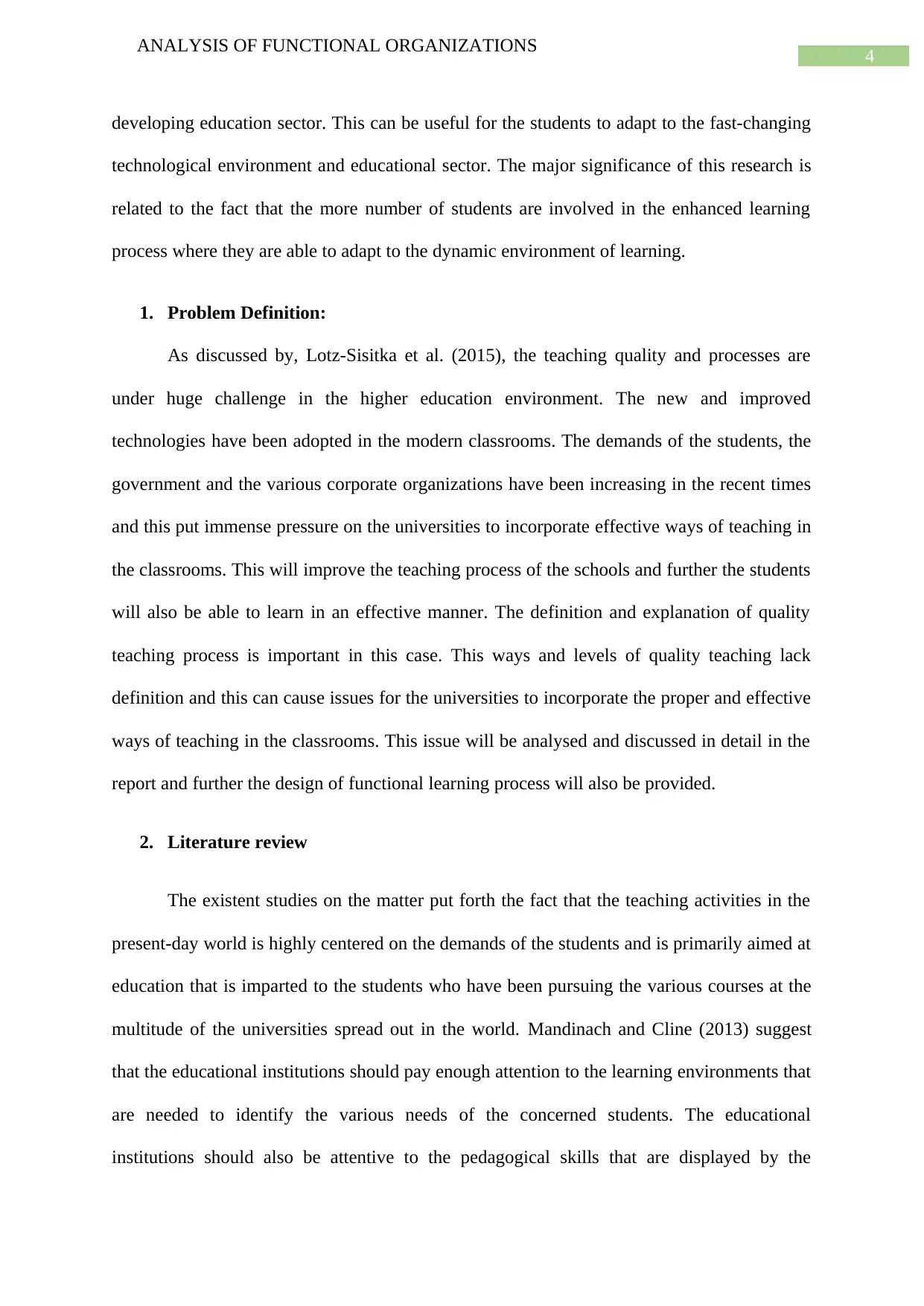
4
ANALYSIS OF FUNCTIONAL ORGANIZATIONS
developing education sector. This can be useful for the students to adapt to the fast-changing
technological environment and educational sector. The major significance of this research is
related to the fact that the more number of students are involved in the enhanced learning
process where they are able to adapt to the dynamic environment of learning.
1. Problem Definition:
As discussed by, Lotz-Sisitka et al. (2015), the teaching quality and processes are
under huge challenge in the higher education environment. The new and improved
technologies have been adopted in the modern classrooms. The demands of the students, the
government and the various corporate organizations have been increasing in the recent times
and this put immense pressure on the universities to incorporate effective ways of teaching in
the classrooms. This will improve the teaching process of the schools and further the students
will also be able to learn in an effective manner. The definition and explanation of quality
teaching process is important in this case. This ways and levels of quality teaching lack
definition and this can cause issues for the universities to incorporate the proper and effective
ways of teaching in the classrooms. This issue will be analysed and discussed in detail in the
report and further the design of functional learning process will also be provided.
2. Literature review
The existent studies on the matter put forth the fact that the teaching activities in the
present-day world is highly centered on the demands of the students and is primarily aimed at
education that is imparted to the students who have been pursuing the various courses at the
multitude of the universities spread out in the world. Mandinach and Cline (2013) suggest
that the educational institutions should pay enough attention to the learning environments that
are needed to identify the various needs of the concerned students. The educational
institutions should also be attentive to the pedagogical skills that are displayed by the
ANALYSIS OF FUNCTIONAL ORGANIZATIONS
developing education sector. This can be useful for the students to adapt to the fast-changing
technological environment and educational sector. The major significance of this research is
related to the fact that the more number of students are involved in the enhanced learning
process where they are able to adapt to the dynamic environment of learning.
1. Problem Definition:
As discussed by, Lotz-Sisitka et al. (2015), the teaching quality and processes are
under huge challenge in the higher education environment. The new and improved
technologies have been adopted in the modern classrooms. The demands of the students, the
government and the various corporate organizations have been increasing in the recent times
and this put immense pressure on the universities to incorporate effective ways of teaching in
the classrooms. This will improve the teaching process of the schools and further the students
will also be able to learn in an effective manner. The definition and explanation of quality
teaching process is important in this case. This ways and levels of quality teaching lack
definition and this can cause issues for the universities to incorporate the proper and effective
ways of teaching in the classrooms. This issue will be analysed and discussed in detail in the
report and further the design of functional learning process will also be provided.
2. Literature review
The existent studies on the matter put forth the fact that the teaching activities in the
present-day world is highly centered on the demands of the students and is primarily aimed at
education that is imparted to the students who have been pursuing the various courses at the
multitude of the universities spread out in the world. Mandinach and Cline (2013) suggest
that the educational institutions should pay enough attention to the learning environments that
are needed to identify the various needs of the concerned students. The educational
institutions should also be attentive to the pedagogical skills that are displayed by the
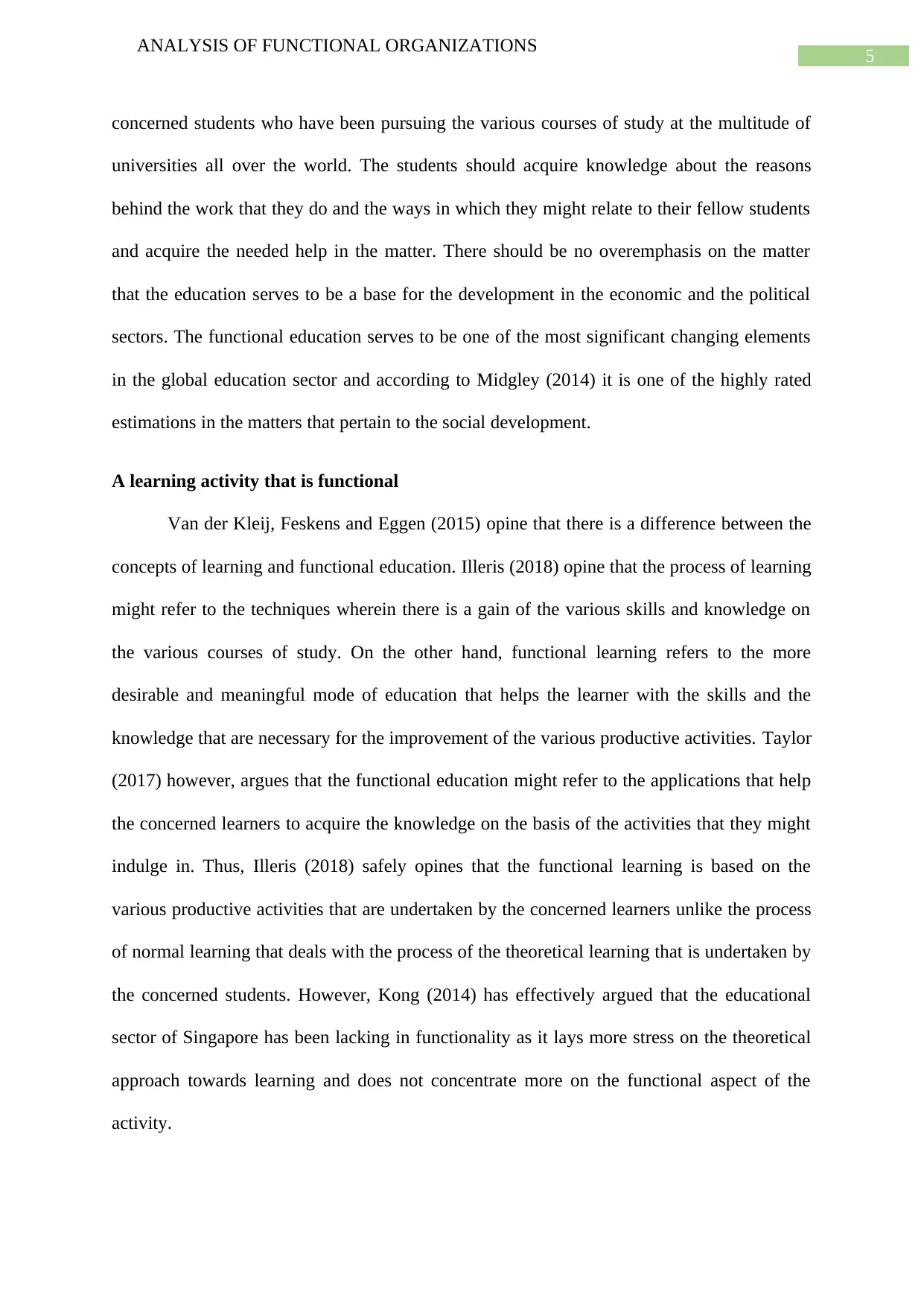
5
ANALYSIS OF FUNCTIONAL ORGANIZATIONS
concerned students who have been pursuing the various courses of study at the multitude of
universities all over the world. The students should acquire knowledge about the reasons
behind the work that they do and the ways in which they might relate to their fellow students
and acquire the needed help in the matter. There should be no overemphasis on the matter
that the education serves to be a base for the development in the economic and the political
sectors. The functional education serves to be one of the most significant changing elements
in the global education sector and according to Midgley (2014) it is one of the highly rated
estimations in the matters that pertain to the social development.
A learning activity that is functional
Van der Kleij, Feskens and Eggen (2015) opine that there is a difference between the
concepts of learning and functional education. Illeris (2018) opine that the process of learning
might refer to the techniques wherein there is a gain of the various skills and knowledge on
the various courses of study. On the other hand, functional learning refers to the more
desirable and meaningful mode of education that helps the learner with the skills and the
knowledge that are necessary for the improvement of the various productive activities. Taylor
(2017) however, argues that the functional education might refer to the applications that help
the concerned learners to acquire the knowledge on the basis of the activities that they might
indulge in. Thus, Illeris (2018) safely opines that the functional learning is based on the
various productive activities that are undertaken by the concerned learners unlike the process
of normal learning that deals with the process of the theoretical learning that is undertaken by
the concerned students. However, Kong (2014) has effectively argued that the educational
sector of Singapore has been lacking in functionality as it lays more stress on the theoretical
approach towards learning and does not concentrate more on the functional aspect of the
activity.
ANALYSIS OF FUNCTIONAL ORGANIZATIONS
concerned students who have been pursuing the various courses of study at the multitude of
universities all over the world. The students should acquire knowledge about the reasons
behind the work that they do and the ways in which they might relate to their fellow students
and acquire the needed help in the matter. There should be no overemphasis on the matter
that the education serves to be a base for the development in the economic and the political
sectors. The functional education serves to be one of the most significant changing elements
in the global education sector and according to Midgley (2014) it is one of the highly rated
estimations in the matters that pertain to the social development.
A learning activity that is functional
Van der Kleij, Feskens and Eggen (2015) opine that there is a difference between the
concepts of learning and functional education. Illeris (2018) opine that the process of learning
might refer to the techniques wherein there is a gain of the various skills and knowledge on
the various courses of study. On the other hand, functional learning refers to the more
desirable and meaningful mode of education that helps the learner with the skills and the
knowledge that are necessary for the improvement of the various productive activities. Taylor
(2017) however, argues that the functional education might refer to the applications that help
the concerned learners to acquire the knowledge on the basis of the activities that they might
indulge in. Thus, Illeris (2018) safely opines that the functional learning is based on the
various productive activities that are undertaken by the concerned learners unlike the process
of normal learning that deals with the process of the theoretical learning that is undertaken by
the concerned students. However, Kong (2014) has effectively argued that the educational
sector of Singapore has been lacking in functionality as it lays more stress on the theoretical
approach towards learning and does not concentrate more on the functional aspect of the
activity.
⊘ This is a preview!⊘
Do you want full access?
Subscribe today to unlock all pages.

Trusted by 1+ million students worldwide
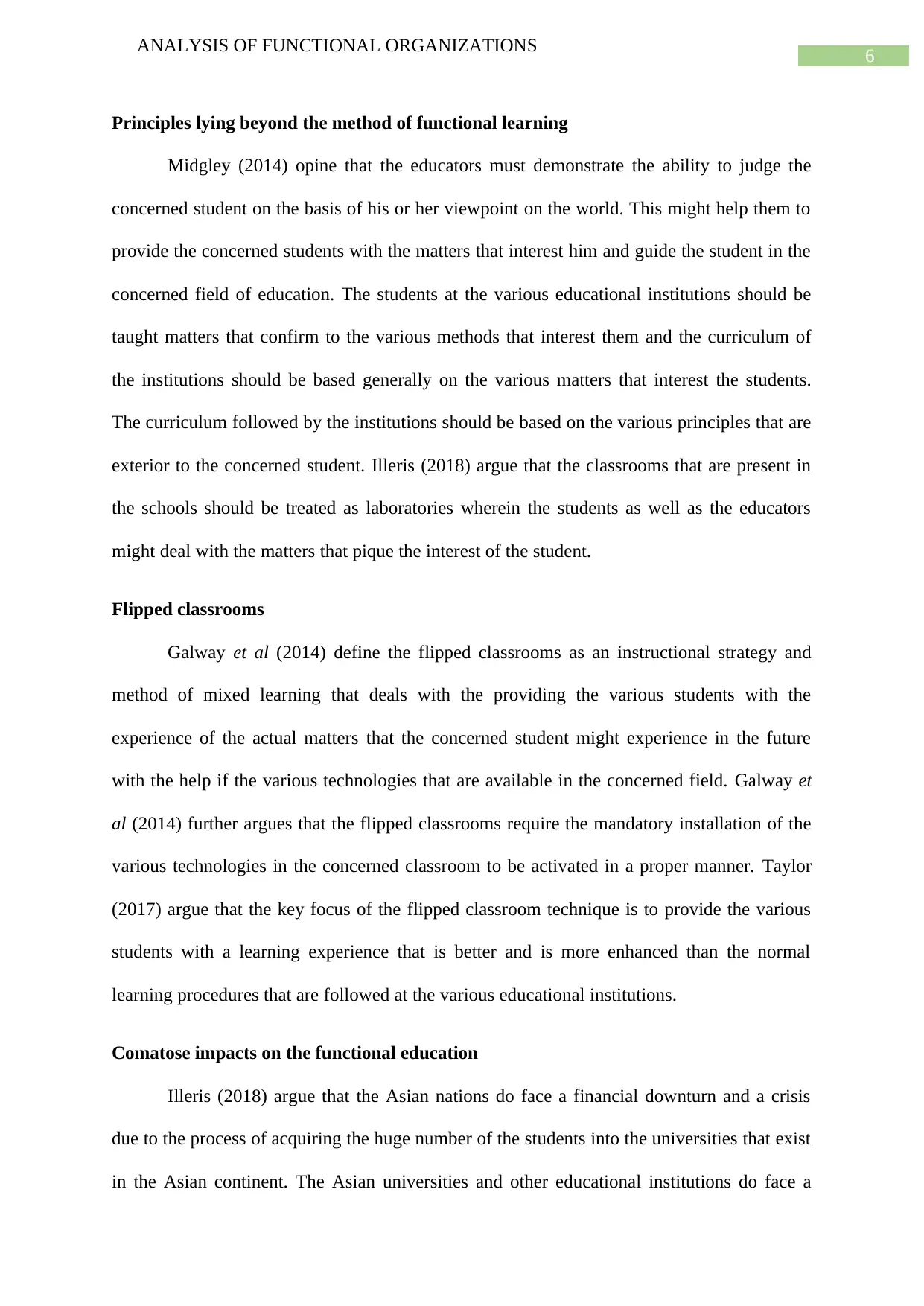
6
ANALYSIS OF FUNCTIONAL ORGANIZATIONS
Principles lying beyond the method of functional learning
Midgley (2014) opine that the educators must demonstrate the ability to judge the
concerned student on the basis of his or her viewpoint on the world. This might help them to
provide the concerned students with the matters that interest him and guide the student in the
concerned field of education. The students at the various educational institutions should be
taught matters that confirm to the various methods that interest them and the curriculum of
the institutions should be based generally on the various matters that interest the students.
The curriculum followed by the institutions should be based on the various principles that are
exterior to the concerned student. Illeris (2018) argue that the classrooms that are present in
the schools should be treated as laboratories wherein the students as well as the educators
might deal with the matters that pique the interest of the student.
Flipped classrooms
Galway et al (2014) define the flipped classrooms as an instructional strategy and
method of mixed learning that deals with the providing the various students with the
experience of the actual matters that the concerned student might experience in the future
with the help if the various technologies that are available in the concerned field. Galway et
al (2014) further argues that the flipped classrooms require the mandatory installation of the
various technologies in the concerned classroom to be activated in a proper manner. Taylor
(2017) argue that the key focus of the flipped classroom technique is to provide the various
students with a learning experience that is better and is more enhanced than the normal
learning procedures that are followed at the various educational institutions.
Comatose impacts on the functional education
Illeris (2018) argue that the Asian nations do face a financial downturn and a crisis
due to the process of acquiring the huge number of the students into the universities that exist
in the Asian continent. The Asian universities and other educational institutions do face a
ANALYSIS OF FUNCTIONAL ORGANIZATIONS
Principles lying beyond the method of functional learning
Midgley (2014) opine that the educators must demonstrate the ability to judge the
concerned student on the basis of his or her viewpoint on the world. This might help them to
provide the concerned students with the matters that interest him and guide the student in the
concerned field of education. The students at the various educational institutions should be
taught matters that confirm to the various methods that interest them and the curriculum of
the institutions should be based generally on the various matters that interest the students.
The curriculum followed by the institutions should be based on the various principles that are
exterior to the concerned student. Illeris (2018) argue that the classrooms that are present in
the schools should be treated as laboratories wherein the students as well as the educators
might deal with the matters that pique the interest of the student.
Flipped classrooms
Galway et al (2014) define the flipped classrooms as an instructional strategy and
method of mixed learning that deals with the providing the various students with the
experience of the actual matters that the concerned student might experience in the future
with the help if the various technologies that are available in the concerned field. Galway et
al (2014) further argues that the flipped classrooms require the mandatory installation of the
various technologies in the concerned classroom to be activated in a proper manner. Taylor
(2017) argue that the key focus of the flipped classroom technique is to provide the various
students with a learning experience that is better and is more enhanced than the normal
learning procedures that are followed at the various educational institutions.
Comatose impacts on the functional education
Illeris (2018) argue that the Asian nations do face a financial downturn and a crisis
due to the process of acquiring the huge number of the students into the universities that exist
in the Asian continent. The Asian universities and other educational institutions do face a
Paraphrase This Document
Need a fresh take? Get an instant paraphrase of this document with our AI Paraphraser
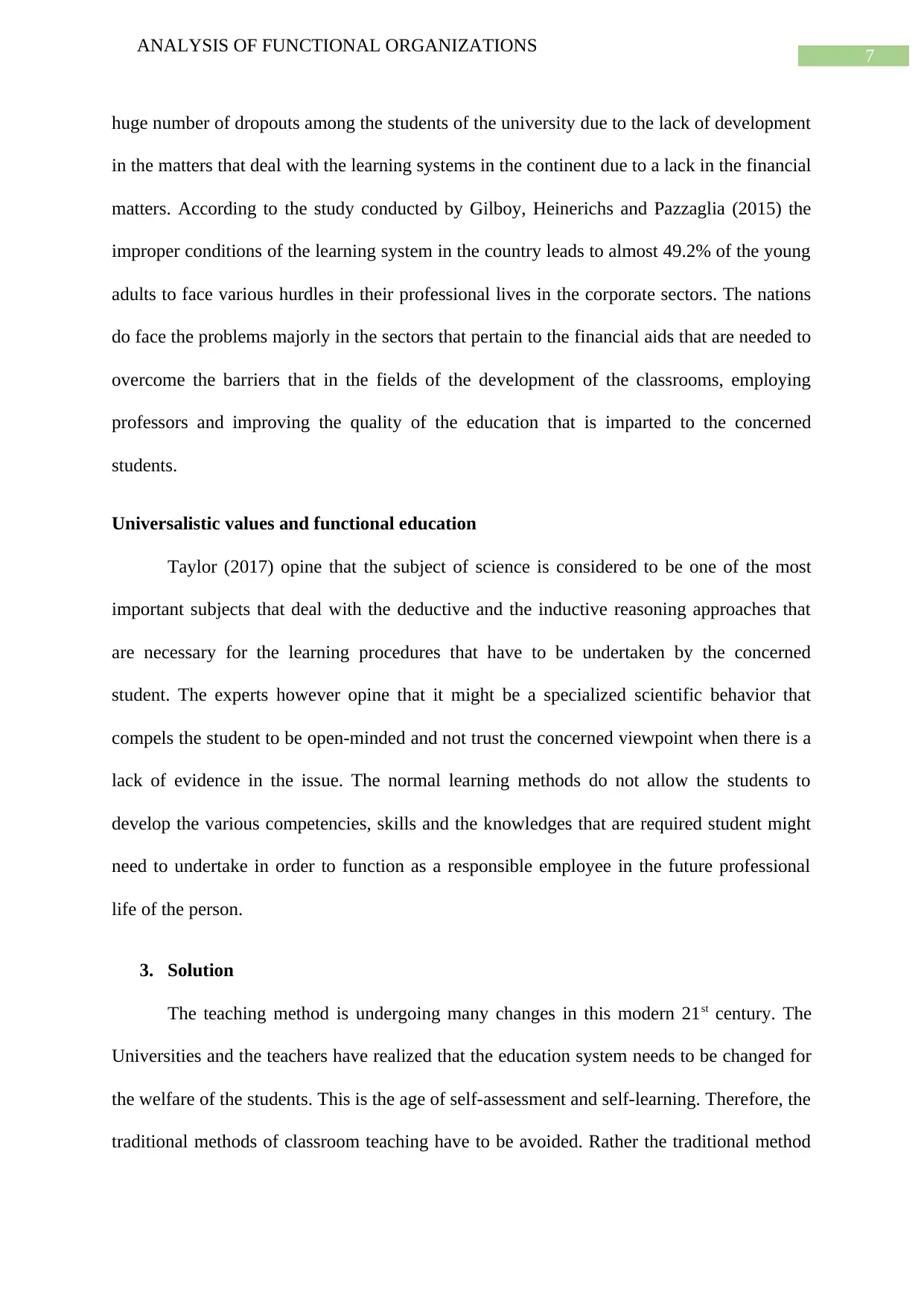
7
ANALYSIS OF FUNCTIONAL ORGANIZATIONS
huge number of dropouts among the students of the university due to the lack of development
in the matters that deal with the learning systems in the continent due to a lack in the financial
matters. According to the study conducted by Gilboy, Heinerichs and Pazzaglia (2015) the
improper conditions of the learning system in the country leads to almost 49.2% of the young
adults to face various hurdles in their professional lives in the corporate sectors. The nations
do face the problems majorly in the sectors that pertain to the financial aids that are needed to
overcome the barriers that in the fields of the development of the classrooms, employing
professors and improving the quality of the education that is imparted to the concerned
students.
Universalistic values and functional education
Taylor (2017) opine that the subject of science is considered to be one of the most
important subjects that deal with the deductive and the inductive reasoning approaches that
are necessary for the learning procedures that have to be undertaken by the concerned
student. The experts however opine that it might be a specialized scientific behavior that
compels the student to be open-minded and not trust the concerned viewpoint when there is a
lack of evidence in the issue. The normal learning methods do not allow the students to
develop the various competencies, skills and the knowledges that are required student might
need to undertake in order to function as a responsible employee in the future professional
life of the person.
3. Solution
The teaching method is undergoing many changes in this modern 21st century. The
Universities and the teachers have realized that the education system needs to be changed for
the welfare of the students. This is the age of self-assessment and self-learning. Therefore, the
traditional methods of classroom teaching have to be avoided. Rather the traditional method
ANALYSIS OF FUNCTIONAL ORGANIZATIONS
huge number of dropouts among the students of the university due to the lack of development
in the matters that deal with the learning systems in the continent due to a lack in the financial
matters. According to the study conducted by Gilboy, Heinerichs and Pazzaglia (2015) the
improper conditions of the learning system in the country leads to almost 49.2% of the young
adults to face various hurdles in their professional lives in the corporate sectors. The nations
do face the problems majorly in the sectors that pertain to the financial aids that are needed to
overcome the barriers that in the fields of the development of the classrooms, employing
professors and improving the quality of the education that is imparted to the concerned
students.
Universalistic values and functional education
Taylor (2017) opine that the subject of science is considered to be one of the most
important subjects that deal with the deductive and the inductive reasoning approaches that
are necessary for the learning procedures that have to be undertaken by the concerned
student. The experts however opine that it might be a specialized scientific behavior that
compels the student to be open-minded and not trust the concerned viewpoint when there is a
lack of evidence in the issue. The normal learning methods do not allow the students to
develop the various competencies, skills and the knowledges that are required student might
need to undertake in order to function as a responsible employee in the future professional
life of the person.
3. Solution
The teaching method is undergoing many changes in this modern 21st century. The
Universities and the teachers have realized that the education system needs to be changed for
the welfare of the students. This is the age of self-assessment and self-learning. Therefore, the
traditional methods of classroom teaching have to be avoided. Rather the traditional method
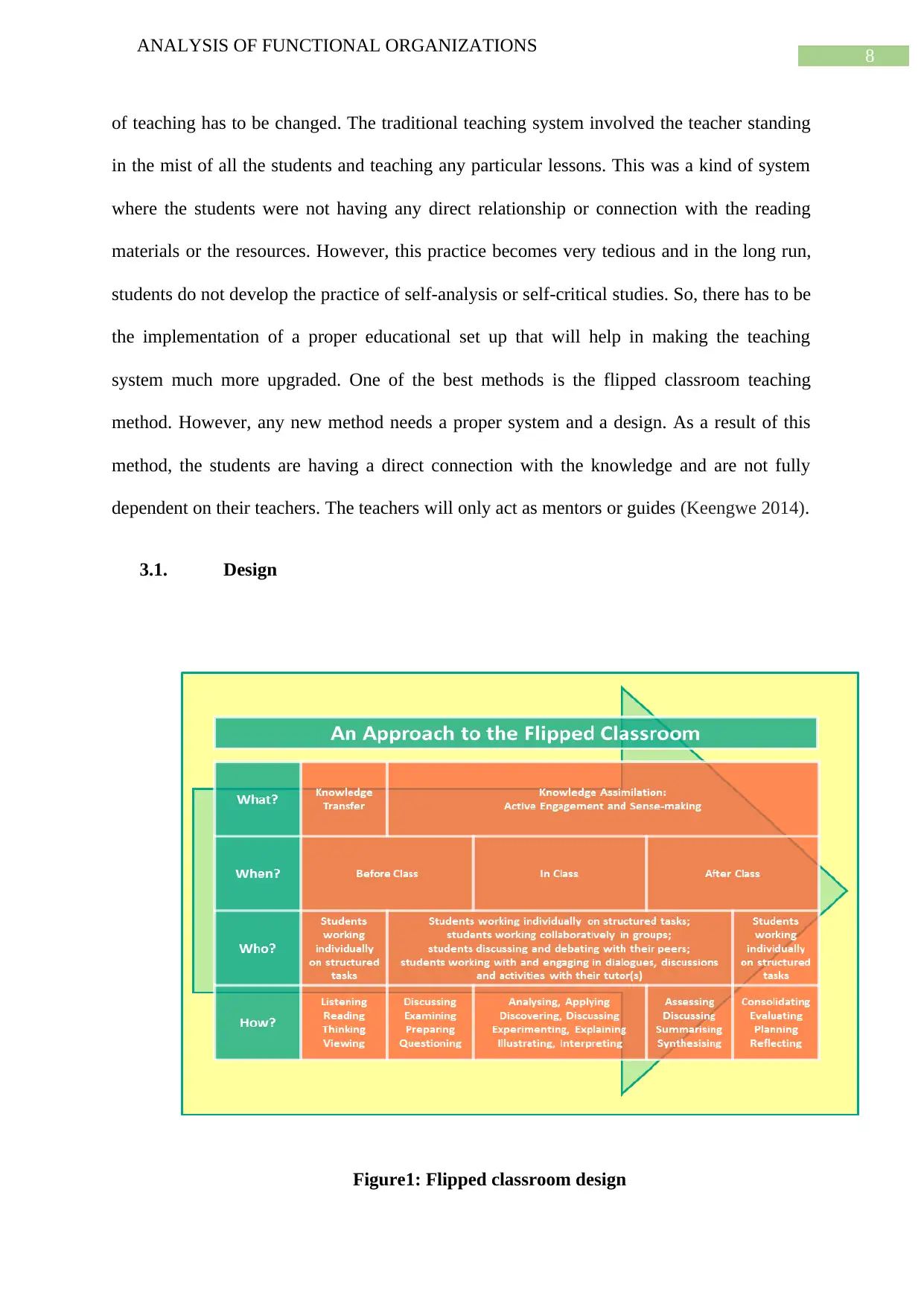
8
ANALYSIS OF FUNCTIONAL ORGANIZATIONS
of teaching has to be changed. The traditional teaching system involved the teacher standing
in the mist of all the students and teaching any particular lessons. This was a kind of system
where the students were not having any direct relationship or connection with the reading
materials or the resources. However, this practice becomes very tedious and in the long run,
students do not develop the practice of self-analysis or self-critical studies. So, there has to be
the implementation of a proper educational set up that will help in making the teaching
system much more upgraded. One of the best methods is the flipped classroom teaching
method. However, any new method needs a proper system and a design. As a result of this
method, the students are having a direct connection with the knowledge and are not fully
dependent on their teachers. The teachers will only act as mentors or guides (Keengwe 2014).
3.1. Design
Figure1: Flipped classroom design
ANALYSIS OF FUNCTIONAL ORGANIZATIONS
of teaching has to be changed. The traditional teaching system involved the teacher standing
in the mist of all the students and teaching any particular lessons. This was a kind of system
where the students were not having any direct relationship or connection with the reading
materials or the resources. However, this practice becomes very tedious and in the long run,
students do not develop the practice of self-analysis or self-critical studies. So, there has to be
the implementation of a proper educational set up that will help in making the teaching
system much more upgraded. One of the best methods is the flipped classroom teaching
method. However, any new method needs a proper system and a design. As a result of this
method, the students are having a direct connection with the knowledge and are not fully
dependent on their teachers. The teachers will only act as mentors or guides (Keengwe 2014).
3.1. Design
Figure1: Flipped classroom design
⊘ This is a preview!⊘
Do you want full access?
Subscribe today to unlock all pages.

Trusted by 1+ million students worldwide
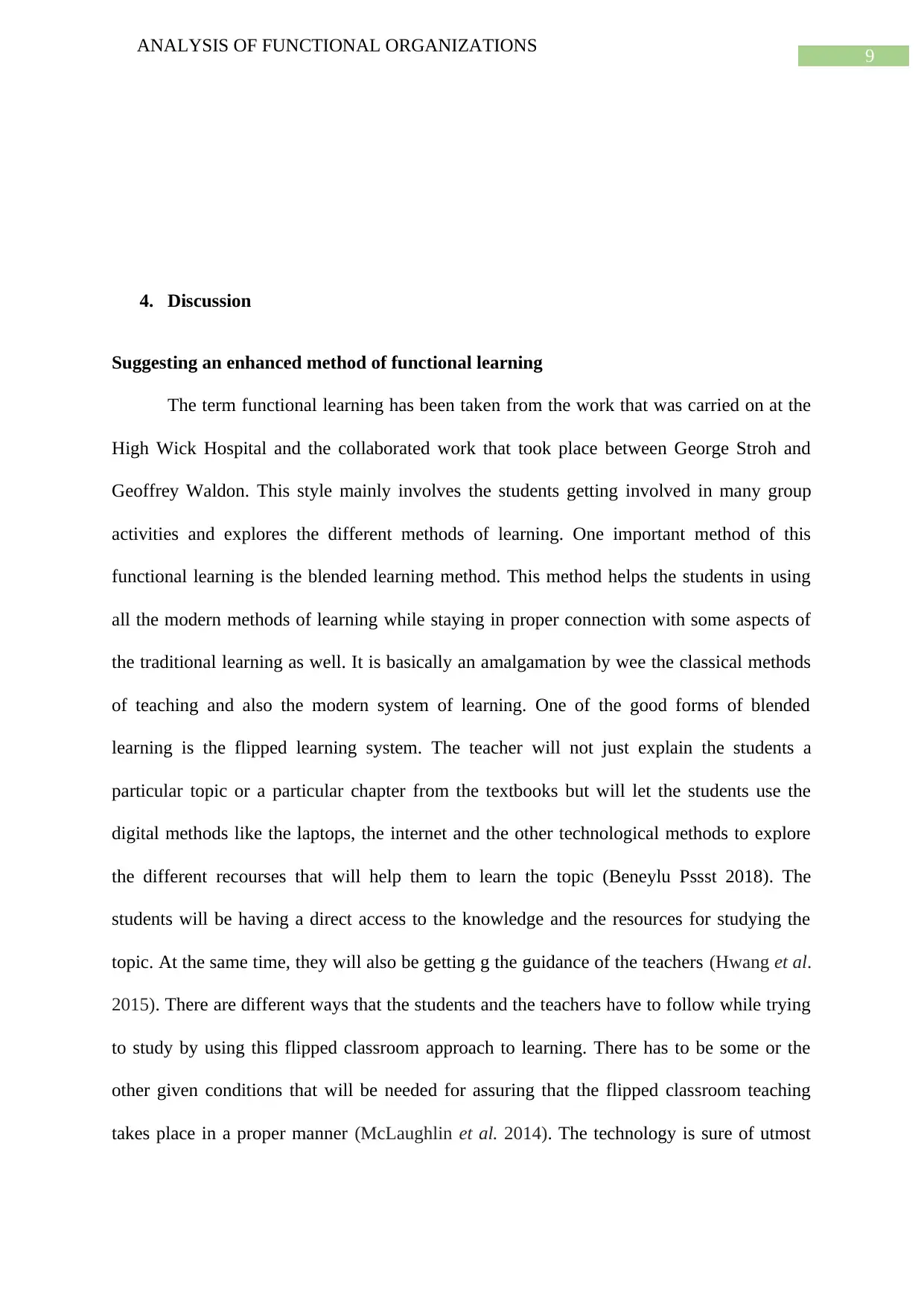
9
ANALYSIS OF FUNCTIONAL ORGANIZATIONS
4. Discussion
Suggesting an enhanced method of functional learning
The term functional learning has been taken from the work that was carried on at the
High Wick Hospital and the collaborated work that took place between George Stroh and
Geoffrey Waldon. This style mainly involves the students getting involved in many group
activities and explores the different methods of learning. One important method of this
functional learning is the blended learning method. This method helps the students in using
all the modern methods of learning while staying in proper connection with some aspects of
the traditional learning as well. It is basically an amalgamation by wee the classical methods
of teaching and also the modern system of learning. One of the good forms of blended
learning is the flipped learning system. The teacher will not just explain the students a
particular topic or a particular chapter from the textbooks but will let the students use the
digital methods like the laptops, the internet and the other technological methods to explore
the different recourses that will help them to learn the topic (Beneylu Pssst 2018). The
students will be having a direct access to the knowledge and the resources for studying the
topic. At the same time, they will also be getting g the guidance of the teachers (Hwang et al.
2015). There are different ways that the students and the teachers have to follow while trying
to study by using this flipped classroom approach to learning. There has to be some or the
other given conditions that will be needed for assuring that the flipped classroom teaching
takes place in a proper manner (McLaughlin et al. 2014). The technology is sure of utmost
ANALYSIS OF FUNCTIONAL ORGANIZATIONS
4. Discussion
Suggesting an enhanced method of functional learning
The term functional learning has been taken from the work that was carried on at the
High Wick Hospital and the collaborated work that took place between George Stroh and
Geoffrey Waldon. This style mainly involves the students getting involved in many group
activities and explores the different methods of learning. One important method of this
functional learning is the blended learning method. This method helps the students in using
all the modern methods of learning while staying in proper connection with some aspects of
the traditional learning as well. It is basically an amalgamation by wee the classical methods
of teaching and also the modern system of learning. One of the good forms of blended
learning is the flipped learning system. The teacher will not just explain the students a
particular topic or a particular chapter from the textbooks but will let the students use the
digital methods like the laptops, the internet and the other technological methods to explore
the different recourses that will help them to learn the topic (Beneylu Pssst 2018). The
students will be having a direct access to the knowledge and the resources for studying the
topic. At the same time, they will also be getting g the guidance of the teachers (Hwang et al.
2015). There are different ways that the students and the teachers have to follow while trying
to study by using this flipped classroom approach to learning. There has to be some or the
other given conditions that will be needed for assuring that the flipped classroom teaching
takes place in a proper manner (McLaughlin et al. 2014). The technology is sure of utmost
Paraphrase This Document
Need a fresh take? Get an instant paraphrase of this document with our AI Paraphraser
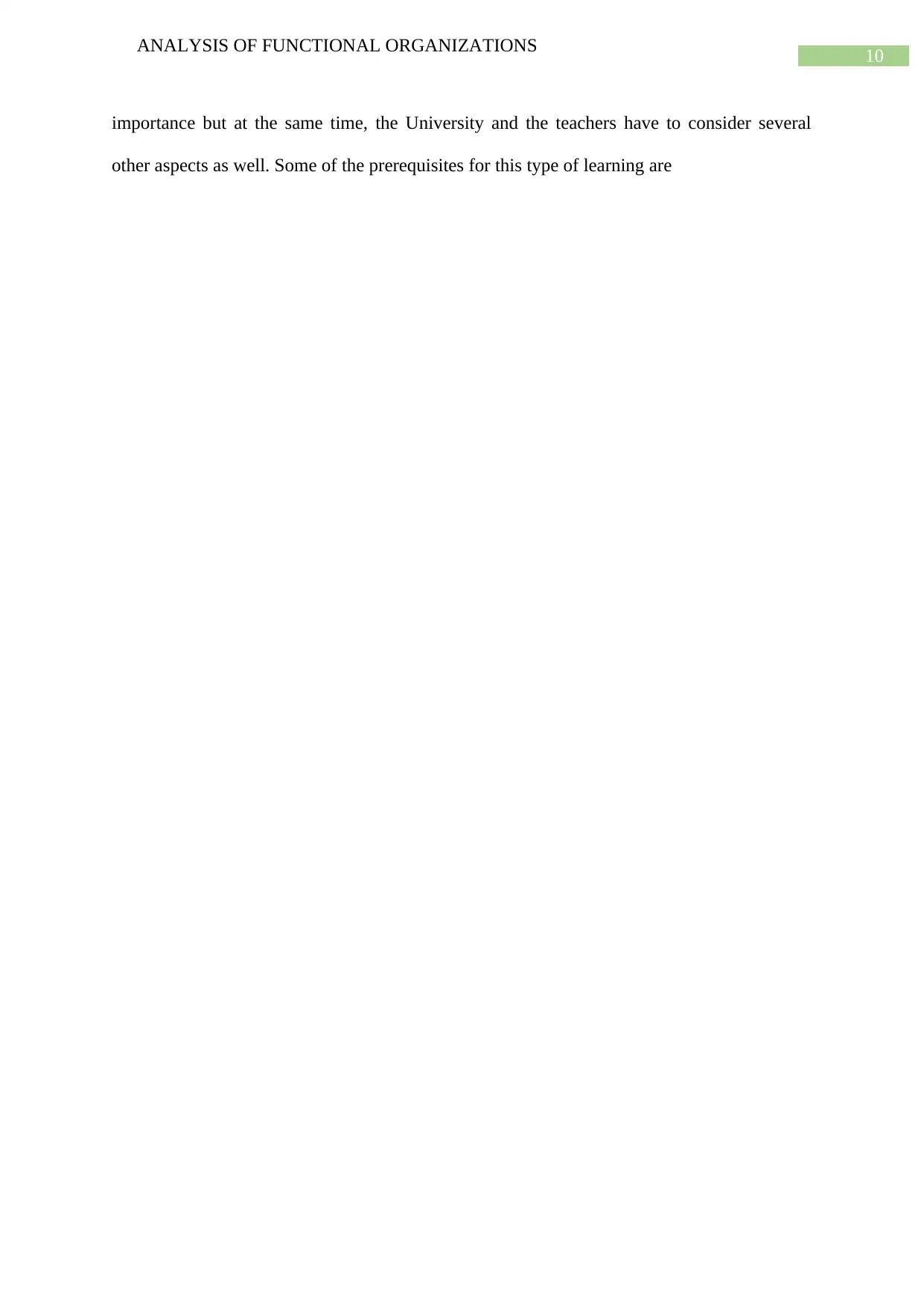
10
ANALYSIS OF FUNCTIONAL ORGANIZATIONS
importance but at the same time, the University and the teachers have to consider several
other aspects as well. Some of the prerequisites for this type of learning are
ANALYSIS OF FUNCTIONAL ORGANIZATIONS
importance but at the same time, the University and the teachers have to consider several
other aspects as well. Some of the prerequisites for this type of learning are
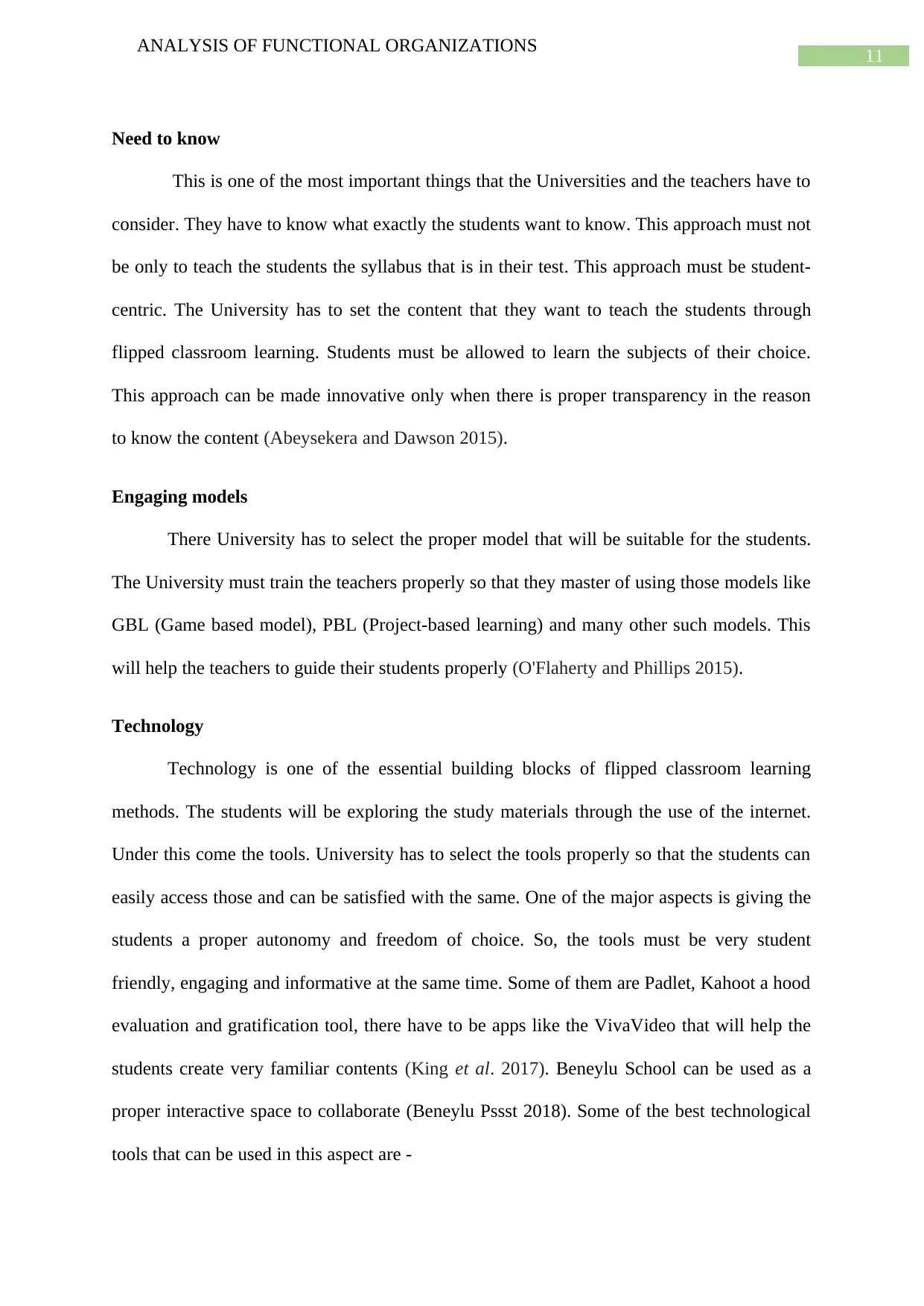
11
ANALYSIS OF FUNCTIONAL ORGANIZATIONS
Need to know
This is one of the most important things that the Universities and the teachers have to
consider. They have to know what exactly the students want to know. This approach must not
be only to teach the students the syllabus that is in their test. This approach must be student-
centric. The University has to set the content that they want to teach the students through
flipped classroom learning. Students must be allowed to learn the subjects of their choice.
This approach can be made innovative only when there is proper transparency in the reason
to know the content (Abeysekera and Dawson 2015).
Engaging models
There University has to select the proper model that will be suitable for the students.
The University must train the teachers properly so that they master of using those models like
GBL (Game based model), PBL (Project-based learning) and many other such models. This
will help the teachers to guide their students properly (O'Flaherty and Phillips 2015).
Technology
Technology is one of the essential building blocks of flipped classroom learning
methods. The students will be exploring the study materials through the use of the internet.
Under this come the tools. University has to select the tools properly so that the students can
easily access those and can be satisfied with the same. One of the major aspects is giving the
students a proper autonomy and freedom of choice. So, the tools must be very student
friendly, engaging and informative at the same time. Some of them are Padlet, Kahoot a hood
evaluation and gratification tool, there have to be apps like the VivaVideo that will help the
students create very familiar contents (King et al. 2017). Beneylu School can be used as a
proper interactive space to collaborate (Beneylu Pssst 2018). Some of the best technological
tools that can be used in this aspect are -
ANALYSIS OF FUNCTIONAL ORGANIZATIONS
Need to know
This is one of the most important things that the Universities and the teachers have to
consider. They have to know what exactly the students want to know. This approach must not
be only to teach the students the syllabus that is in their test. This approach must be student-
centric. The University has to set the content that they want to teach the students through
flipped classroom learning. Students must be allowed to learn the subjects of their choice.
This approach can be made innovative only when there is proper transparency in the reason
to know the content (Abeysekera and Dawson 2015).
Engaging models
There University has to select the proper model that will be suitable for the students.
The University must train the teachers properly so that they master of using those models like
GBL (Game based model), PBL (Project-based learning) and many other such models. This
will help the teachers to guide their students properly (O'Flaherty and Phillips 2015).
Technology
Technology is one of the essential building blocks of flipped classroom learning
methods. The students will be exploring the study materials through the use of the internet.
Under this come the tools. University has to select the tools properly so that the students can
easily access those and can be satisfied with the same. One of the major aspects is giving the
students a proper autonomy and freedom of choice. So, the tools must be very student
friendly, engaging and informative at the same time. Some of them are Padlet, Kahoot a hood
evaluation and gratification tool, there have to be apps like the VivaVideo that will help the
students create very familiar contents (King et al. 2017). Beneylu School can be used as a
proper interactive space to collaborate (Beneylu Pssst 2018). Some of the best technological
tools that can be used in this aspect are -
⊘ This is a preview!⊘
Do you want full access?
Subscribe today to unlock all pages.

Trusted by 1+ million students worldwide
1 out of 19
Related Documents
Your All-in-One AI-Powered Toolkit for Academic Success.
+13062052269
info@desklib.com
Available 24*7 on WhatsApp / Email
![[object Object]](/_next/static/media/star-bottom.7253800d.svg)
Unlock your academic potential
Copyright © 2020–2025 A2Z Services. All Rights Reserved. Developed and managed by ZUCOL.





